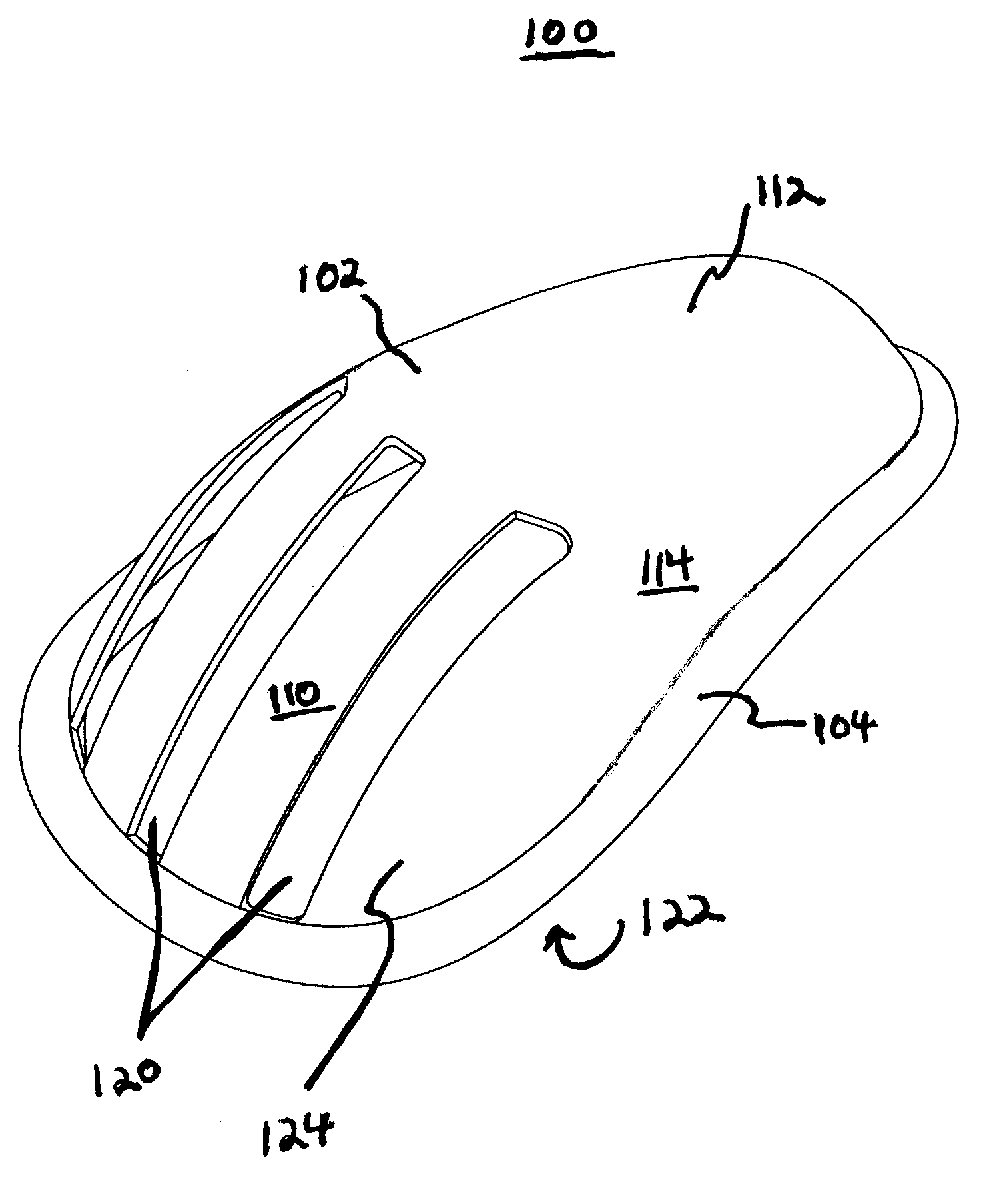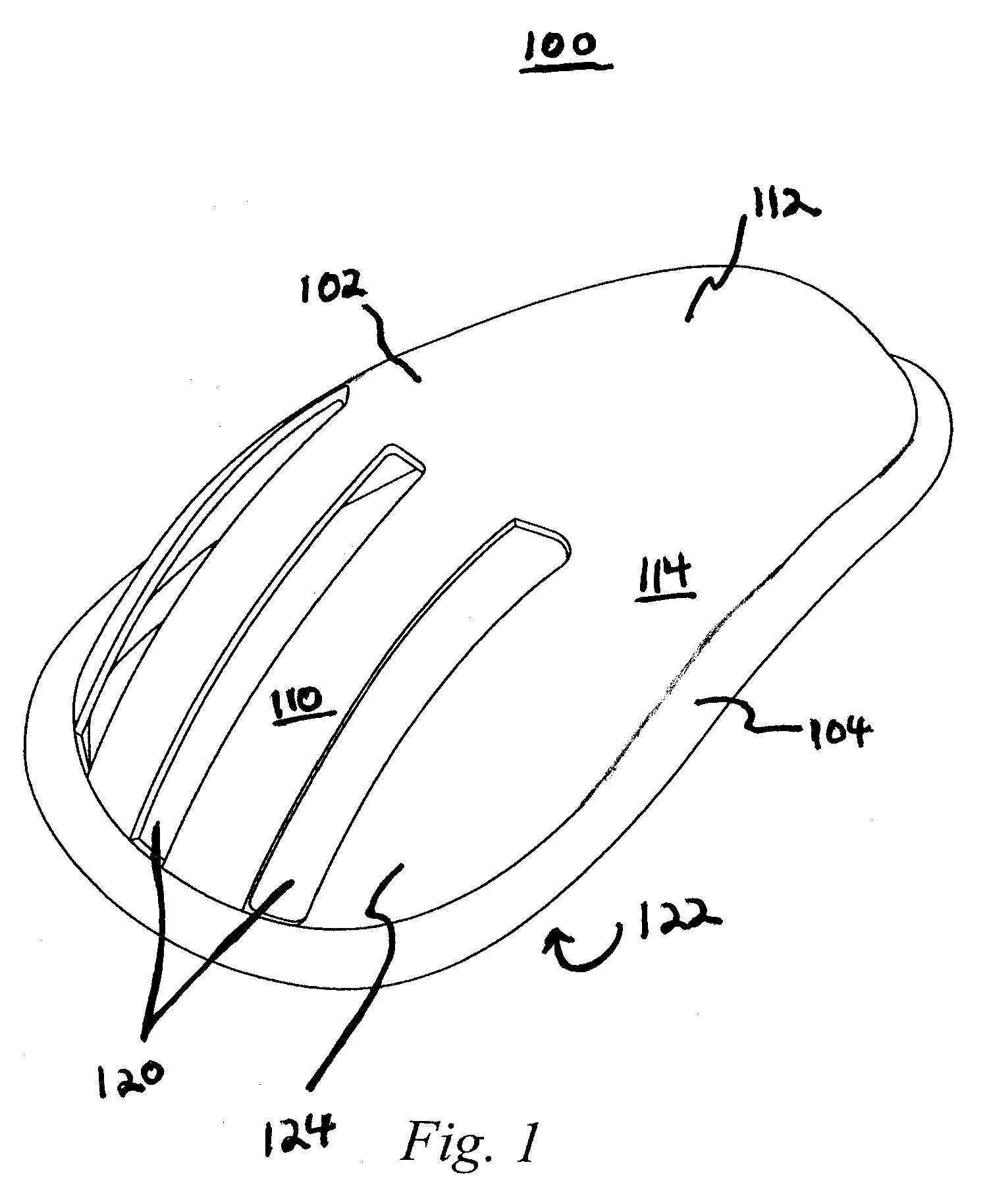Protective cup and method of manufacturing the protective cup
a protective cup and cup body technology, applied in the field of protective cups, can solve the problems of tiring of wearing for an extended period, and restricting the movement of the wearer
- Summary
- Abstract
- Description
- Claims
- Application Information
AI Technical Summary
Benefits of technology
Problems solved by technology
Method used
Image
Examples
first embodiment
[0031]With reference to FIGS. 1-6, a protective cup 100 according to the present invention comprises cage member 102 and peripheral lip 104.
[0032]For a proper fit, the size of protective cup 100 usually varies with the size of the user. FIGS. 2 and 3 define, for example, height H1, breadth B1, and depth D1 for protective cup 100. Protective cup 100 may comprise, for example, a height H1 greater than or equal to about 3 inches and less than or equal to about 12 inches, a breadth B1 greater than or equal to about 2 inches and less than or equal to about 12 inches, and a depth D1 greater than or equal to about 1 inch and less than or equal to about 6 inches; or a height H1 greater than or equal to about 4 inches and less than or equal to about 8 inches, a breadth B1 greater than or equal to about 3 inches and less than or equal to about 6 inches, and a depth D1 greater than or equal to about 2 inches and less than or equal to about 4 inches. However, the actual values of height H1, bre...
second embodiment
[0061]With reference to FIGS. 7-12, a protective cup 200 according to the present invention comprises cage member 202, peripheral lip 204, and linking portions 206 and 208.
[0062]For a proper fit, the size of protective cup 200 usually varies with the size of the user, as discussed with respect to protective cup 100. FIGS. 8 and 9 define, for example, height H2, breadth B2, and depth D2 for protective cup 200. Protective cup 200 may comprise, for example, values of height H2, breadth B2, and depth D2 similar to the values of height H1, breadth B1, and depth D1 for protective cup 100.
[0063]Cage member 202 comprises upper portion 210, lower portion 212, and side portions 214 and 216. Although protective cup 200 may have any desired shape, it may, for example, comprise a concave inner surface 222 and a convex outer surface 224 as shown, for example, in FIGS. 7-12. And, as discussed with respect to protective cup 100, given concave inner surface 222, the centers of gravity of upper porti...
third embodiment
[0081]With reference to FIGS. 13-18, a protective cup 300 according to the present invention comprises cage member 302, peripheral lip 304, and linking portions 306 and 308.
[0082]For a proper fit, the size of protective cup 300 usually varies with the size of the user, as discussed with respect to protective cup 100. FIGS. 14 and 15 define, for example, height H3, breadth B3, and depth D3 for protective cup 300. Protective cup 300 may comprise, for example, values of height H3, breadth B3, and depth D3 similar to the values of height H1, breadth B1, and depth D1 for protective cup 100.
[0083]Cage member 302 comprises upper portion 310, lower portion 312, and side portions 314 and 316. Although protective cup 300 may have any desired shape, it may, for example, comprise a concave inner surface 322 and a convex outer surface 324 as shown, for example, in FIGS. 13-18. And, as discussed with respect to protective cup 100, given concave inner surface 322, the centers of gravity of upper p...
PUM
 Login to View More
Login to View More Abstract
Description
Claims
Application Information
 Login to View More
Login to View More - R&D
- Intellectual Property
- Life Sciences
- Materials
- Tech Scout
- Unparalleled Data Quality
- Higher Quality Content
- 60% Fewer Hallucinations
Browse by: Latest US Patents, China's latest patents, Technical Efficacy Thesaurus, Application Domain, Technology Topic, Popular Technical Reports.
© 2025 PatSnap. All rights reserved.Legal|Privacy policy|Modern Slavery Act Transparency Statement|Sitemap|About US| Contact US: help@patsnap.com



